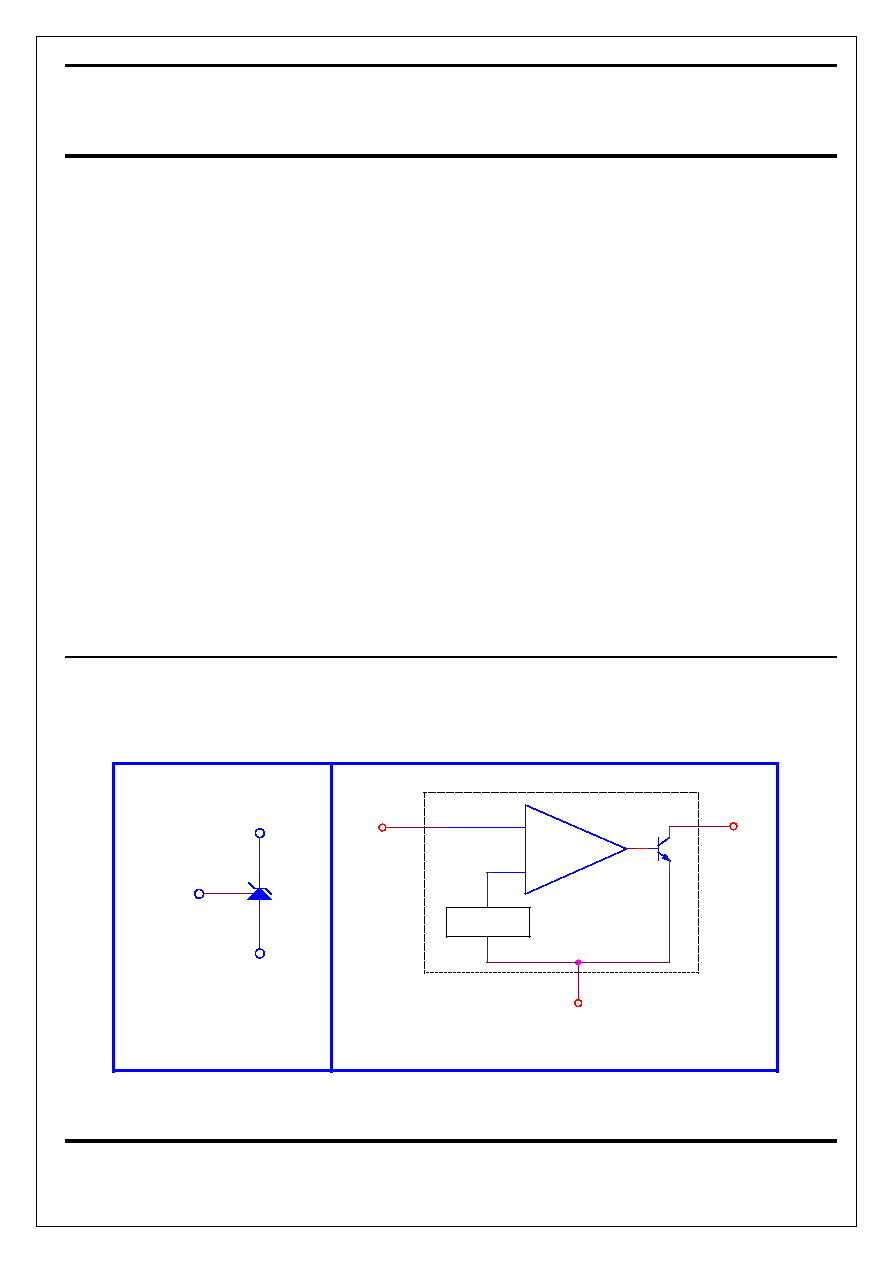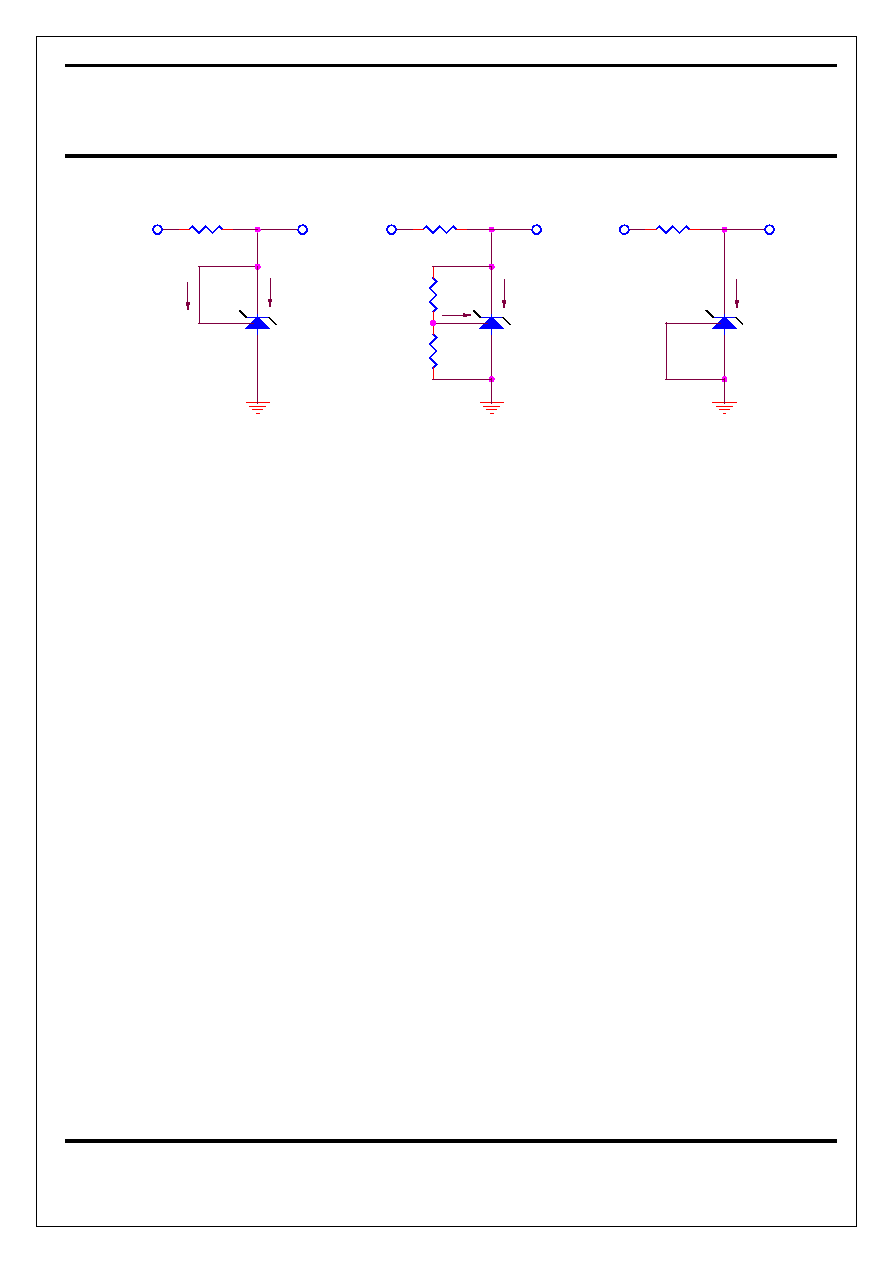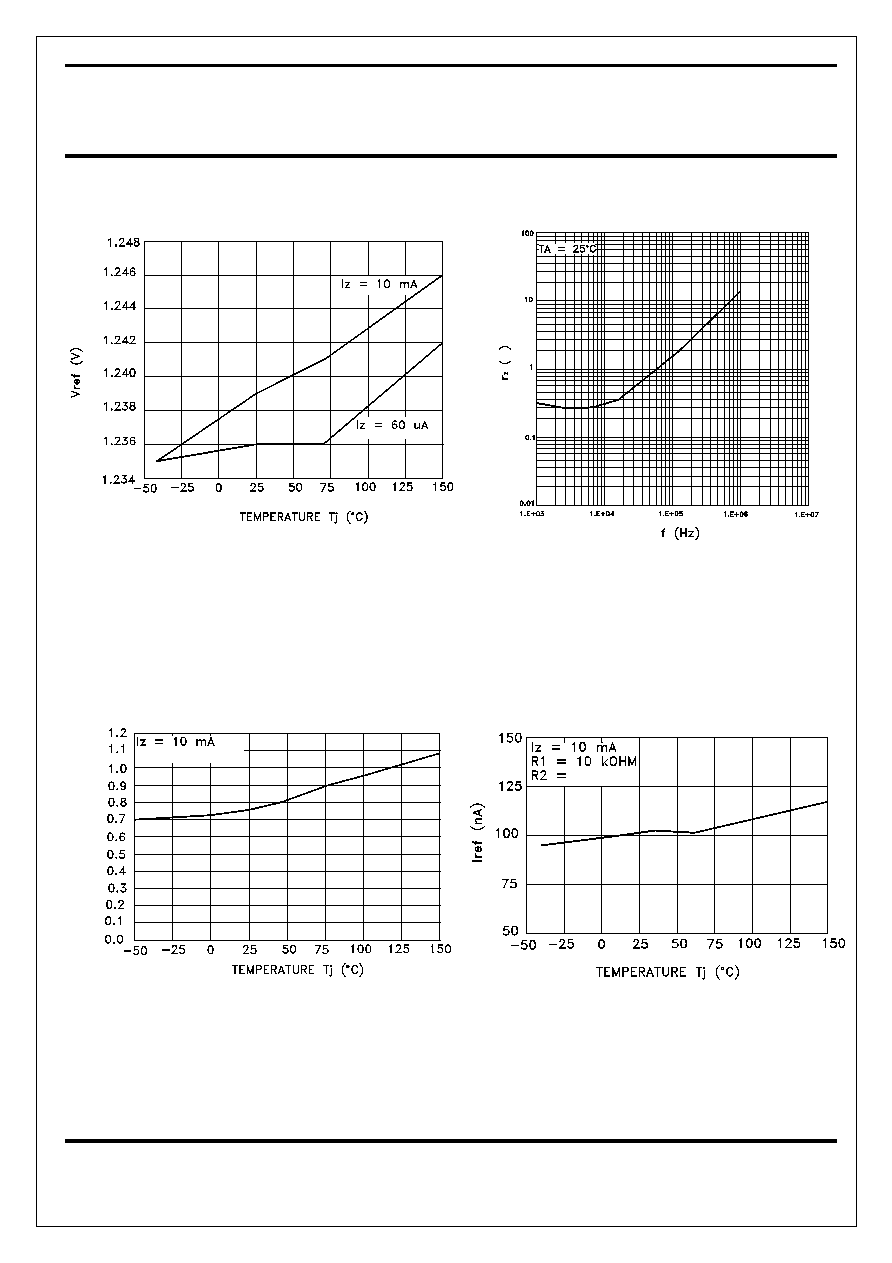
1
1.24V Low-Voltage Adjustable
Precision Shunt Regulator
NIKO-SEM
L432
NOV-21-2001
GENERAL DESCRIPTION
The L432 is a three-terminal adjustable shunt
regulator utilizing an accurate 1.24V band gap
reference. The output voltage can be set to any
value between 1.24V (V
REF
) to 18V with two
external resistors as shown in the typical
application circuit. The device exhibit a wide
operating current range of 0.2 to 100 mA with a
typical dynamic impedance of 0.25. Active
output circuitry provides a very sharp turn-on
characteristic, making the L432 excellent re-
placements for low-voltage zener diodes in
many applications, including on-board regulat-
ion and adjustable power supplies.
When used with an opto-coupler, the L432 is
ideal voltage reference in isolated feedback
circuits for 3.3V switching-mode power supplies.
The L432 shunt regulator is available in two
voltage tolerances (0.5% & 1.0%) and three
package options (TO-92, SOT-23-3 and SO-8).
FEATURES
Internal amplifier with 100 mA capability
Programmable output voltage to 18V
0.25 typical output impedance
Pin to pin compatible with TLV431A,
TS431, SC431L & AS432
Trimmed bandgap design 0.5% & 1.0%
with three package options
Low output noise
APPLICATIONS
Linear regulator controller
Precision voltage reference
Switching power supplies
Battery operating equipment
Instrumentation
PCs, Computer disk drives
SYMBOL & BLOCK DIAGRAM
Anode (A)
Cathod
Reference
-
+
Cathode (K)
Anode (A)
Reference (R)
1.24 Vref
FUNCTIONAL BLOCK DIAGRAM
SYMBOL
(R)
(K)

2
1.24V Low-Voltage Adjustable
Precision Shunt Regulator
NIKO-SEM
L432
NOV-21-2001
ABSOLUTE MAXIMUM RATINGS
PARAMETER
VALUE
Cathode-Anode Reverse Breakdown Voltage - V
KA
20V
Anode-Cathode Forward Current - I
AK
1
A
Operating Cathode Current - I
KA
100
mA
Reference Input Current - I
REF
1
mA
Storage Temperature Range - T
STG
-65 to +150 �C
Junction Temperature - T
J
150
�C
Lead Temperature (Soldering, 10 Seconds) - T
L
300
�C
Continuous Power at 25 �C - P
D
TO-92
SOIC-8
SOT-23
700 mW
650 mW
200 mW
RECOMMENDED CONDITIONS
TYPICAL THERMAL RESISTANCES
Parameter
Rating
Package
JA
JC
Typ. De-rating
Cathode Voltage (V
KA
) V
REF
to 18V
TO-92
160 �C/W
80 �C/W
6.3 mW/�C
Cathode Current (I
K
)
10 mA
SOIC-8
175 �C/W
45 �C/W
5.7 mW/�C
SOT-23 575 �C/W 150 �C/W
1.7 mW/�C
ELECTRICAL SPECIFICATIONS
(Ambient temperature must be derated base on power dissipation and package thermal characteristics. The conditions are: V
KA
= V
REF
and
I
K
= 10 mA unless otherwise stated)
PARAMETER
TEST CONDITIONS
MIN TYP MAX
UNITS
TEST
CIRCUIT
T
A
= 25 �C, L432 (0.5%) 1.234 1.240 1.246
Output Voltage - V
REF
T
A
= 25 �C, L432 (1%) 1.228 1.240 1.252
V 1
Line Regulation -
V
REF
V
KA
= V
REF
to 15V
28
50
mV
2
Load Regulation -
V
REF
I
K
= 1 to 100 mA
3.9
6
mV
1
Temperature Deviation -
V
REF
0 < T
J
< 105 �C
5
12
mV
1
Reference Input Current - I
REF
2.3 6
�A
1
Reference Input Current
Temperature Coefficient -
I
REF
0 < T
J
< 105 �C
0.14
0.6
�A
1
Minimum Cathode Current
for Regulation - I
K(MIN)
0.2
1
mA
1
Off State Leakage - I
K(MIN)
V
REF
= 0V, V
KA
= 15V
40
500
nA
3
Dynamic impedance
V
KA
= V
ref
, f 1kHz
I
K
= 0.1 mA to 100 mA
0.25
0.4
1

3
1.24V Low-Voltage Adjustable
Precision Shunt Regulator
NIKO-SEM
L432
NOV-21-2001
TEST CIRCUITS
IN
V
V
KA
K
I
REF
I
V
REF
R1
R2
- TEST CIRCUIT 2 -
>
(V
KA
V
REF
)
REF
I
)
V
KA
V
=
- TEST CIRCUIT 1 -
KA
V
REF
(V
IN
- TEST CIRCUIT 3 -
KA
V
V
IN
K (OFF)
I
(OFF STATE CURRENT)
I
K
Applications Information � Stability
Selection of load capacitance when using
L432 as a shunt regulator
When the L432 is used as a shunt regulator,
two options for selection of CL are
recommended for optimal stability:
1. No load capacitance across the device,
decouple at the load.
2. Large capacitance across the device,
optional decoupling at the load.
The reason for this is that L432 exhibits
instability with capacitances in the range of
1nF to 1uf (approx.) at light cathode currents
(up to 3mA typical). The device is less stable
the lower the cathode voltage has been set for.
Therefore while the device will be perfectly
stable operating at a cathode current of 10mA
with a 0.1uF capacitor across it, it will oscillate
transiently during start-up as the cathode
current passes through the instability region.
Selecting a very low
(or preferably, no)capacitance, or alter-
natively a high capacitance (such as 10uF)
will avoid this issue altogether. Since the
user will probably wish to have local
decoupling at the load anyway, the most
cost effective method is to use no
capacitance at all directly across the
device. PCB trace/via resistance and
inductance prevent the local load de-
coupling from causing the oscillation during
the transient start-up phase. Note : if the
L432 is located right at the load, so the
load decoupling capacitor is directly across
it, then this capacitor will have to be
100pF or 1uF.

4
1.24V Low-Voltage Adjustable
Precision Shunt Regulator
NIKO-SEM
L432
NOV-21-2001
Stability Boundary Condition For Shunt Regulation
VS. Cathode Current and Load Capacitance
Small-Signal Gain and Phase Shift
VS. Frequency
VS. Cathode Voltage
Cathode Current
CL
1
2
R2
R1
R
Test Circuit for Stability
L432
2
3
1
Iz
Cathode Current
VS. Cathode Voltage
15K
232
GND
1
2
10uF
OUT
1
2
Iz
8.25K
Test Circuit for Small Signal Gain and Phase
L432
2
3
1

5
1.24V Low-Voltage Adjustable
Precision Shunt Regulator
NIKO-SEM
L432
NOV-21-2001
VS. Frequency
Reference Impedance
Reference Voltage
VS. Junction Temperature
Ratio of Delta Reference Voltage to Delta Cathode Voltage
Vz = 16V to Vref
V
r
e
f
/
V
z
(
-
m
V
/
V
)
VS. Junction Temperature
VS. Junction Temperature
Reference Input Current




